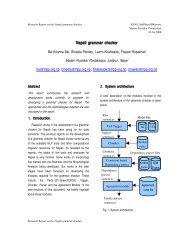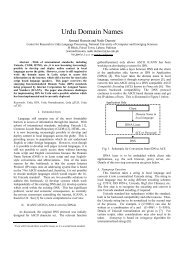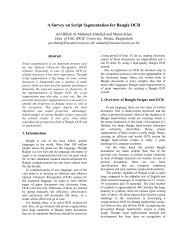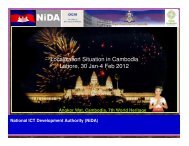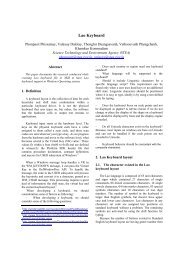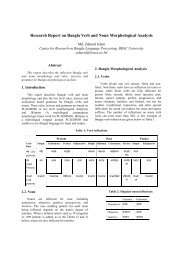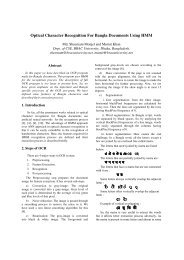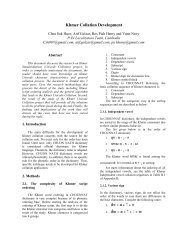Lao Collation - PAN Localization
Lao Collation - PAN Localization
Lao Collation - PAN Localization
You also want an ePaper? Increase the reach of your titles
YUMPU automatically turns print PDFs into web optimized ePapers that Google loves.
<strong>Lao</strong> <strong>Collation</strong>s<br />
By:<br />
Phonpasit PHISSAMAY<br />
Nadir DURRANI<br />
<strong>Lao</strong> <strong>Localization</strong> Project Team
For Nuclear consonants<br />
A. All ligature characters followed after all single consonant:<br />
ກ(1);<br />
ຂ(2);<br />
ຄ(3);<br />
ງ(4);<br />
ຈ(5);<br />
ສ(6);<br />
ຊ(7);<br />
ຍ(8);<br />
ດ(9);<br />
ຕ(10);<br />
ຖ(11);<br />
ທ(12);<br />
ນ(13);<br />
ບ(14);<br />
ປ(15);<br />
ຜ(16);<br />
ຝ(17);<br />
ພ(18);<br />
ຟ(19); (19);ມ(20);(20); ຢ(21);<br />
ຣ(22); (22);ລ(23);(23);<br />
ວ(24);<br />
ຫ(25);<br />
ອ(26);<br />
ຮ(27);<br />
ຫງ(28);<br />
ຫຍ(29);<br />
ຫນ(30);<br />
ໜ(31);<br />
ຫມ(32);<br />
ໝ(33) ; ຫລ(34);<br />
ຫຼ(35);<br />
ຫວ(36).<br />
B. All ligature characters allocated in the group of its first combination<br />
consonant “ຫ(25)” :<br />
ກ(1);<br />
ຂ(2);<br />
ຄ(3);<br />
ງ(4);<br />
ຈ(5);<br />
ສ(6);<br />
ຊ(7);<br />
ຍ(8);<br />
ດ(9);<br />
ຕ(10);<br />
ຖ(11);<br />
ທ(12);<br />
ນ(13);<br />
ບ(14);<br />
ປ(15);<br />
ຜ(16);<br />
ຝ(17);<br />
ພ(18);<br />
ຟ(19); (19);ມ(20);ຢ(21);(21); ຣ(22);<br />
ລ(23);<br />
ວ(24);<br />
ຫ(25);<br />
ຫງ(26);<br />
(26);ຫຍ(27);<br />
ຫນ(28);<br />
ຫມ(29);<br />
ຫລ(30);<br />
ຫຼ(31);<br />
ຫວ(32);<br />
ອ(33); (33); ຮ(34);<br />
ໜ(35);<br />
ໝ(36);<br />
C. All ligature characters allocated in the group of its nuclear consonant:<br />
ກ(1);<br />
ຂ(2);<br />
ຄ(3);<br />
ງ(4);<br />
ຫງ(5);<br />
ຈ(6);<br />
ສ(7);<br />
ຊ(8);<br />
ຍ(9);<br />
ຫຍ(10);<br />
ດ(11);<br />
ຕ(12);<br />
ຖ(13);<br />
ທ(14);<br />
ນ(15);<br />
ຫນ(16);<br />
ໜ(17);<br />
ບ(18);<br />
ປ(19);<br />
ຜ(20);<br />
ຝ(21);<br />
ພ(22);<br />
ຟ(23); (23);ມ(24);(24);<br />
ຫມ(25);<br />
ໝ(26);<br />
ຢ(27);<br />
ຣ(28); (28);ລ(29);(29); ຫລ(30);<br />
ຫຼ(31);<br />
ວ(32);<br />
ຫວ(33);<br />
ຫ(34);<br />
ອ(35);<br />
ຮ(36).
For vowels<br />
A. All combination vowels followed the all single vowels:<br />
xະ(1);<br />
xາ(2);<br />
◌ິ(3);<br />
◌ີ(4);<br />
◌ຶ(5);<br />
◌ື(6);<br />
◌ຸ(7);<br />
◌ູ(8);<br />
ເxະ(9);<br />
ເx(10);<br />
ແxະ(11);<br />
ແx(12);<br />
ໂxະ(13);<br />
ໂx(14);<br />
ເxາະ(15);<br />
◌ໍ(16);<br />
ເ◌ິ(17);<br />
ເ◌ີ(18);<br />
ເ◌ັຽ(19);<br />
ເxຽ(20);<br />
◌ົວະ(21);<br />
◌ົວ(22);<br />
ເ◌ຶອ(23);<br />
ເ◌ືອ(24);<br />
ໄx(25);<br />
ໃx(26);<br />
◌ຳ(27);<br />
ເ◌ົາ(28)<br />
B. The combination allocated into the group of it first component<br />
vowels:<br />
xະ(1);<br />
xາ(2);<br />
◌ິ(3);<br />
◌ີ(4);<br />
◌ຸ(5);<br />
◌ູ(6);<br />
ເx(7);<br />
ເxະ(8);<br />
ເ◌ິ(9);<br />
ເ◌ີ(10);<br />
ເ◌ຶອ(11);<br />
ເ◌ືອ(12);<br />
ເxາະ(13);<br />
ເ◌ົາ(14) ; ເ◌ັ(15);<br />
ເ◌ັຽ(16);<br />
ເxຽ(17);<br />
ແxະ(18);<br />
ແx(19);<br />
ແ◌ັ(20);<br />
ໂx(21);<br />
ໂxວ(22);<br />
ໂxະ(23);<br />
ໂ◌ັກ(24);<br />
◌ໍ(25);<br />
◌ົວ(26);<br />
◌ົວະ(27);<br />
◌ັ(28);<br />
◌ັວ(29);<br />
◌ຳ(30); xວ(31); x<br />
xອ(32); x<br />
xຽ(33) x
<strong>Lao</strong> <strong>Collation</strong><br />
Lack of National Standards<br />
Looking at text books and prevailing lexicons we find<br />
two most commonly used approaches.<br />
– Based on Combinational Consonants and Vowels<br />
– Based on Alphabetical Order
What is <strong>Collation</strong> ?<br />
A term generally taken as a process of sorting out the<br />
set of strings based on lexicographic order.<br />
For example sorting order of English characters based<br />
on their ASCII code is “ABCDE…Z abcde…z”<br />
which is different then its lexicographic order which<br />
is “AaBbCcDdEd…Zz”.<br />
<strong>Collation</strong> is something, driven on base of cultural and<br />
national standards.
Based on Lexicon<br />
Possible Solutions<br />
– Giving weight to each word. So collation involves<br />
primarily searching the word in lexicon and comparing the<br />
weights to sort them.<br />
Discrepancies of this approach<br />
– Brute Force Computing<br />
– Consumes Space<br />
– Consumes Time
Based on Syllabification<br />
Contd..<br />
– Before we can proceed we need to segment the word into<br />
syllables.<br />
– Many <strong>Lao</strong> characters exhibit hybrid behavior. With each<br />
identity they act different when doing collation. We need to<br />
know what role each character is playing within the<br />
syllable.<br />
– To further aggravate the situation a <strong>Lao</strong> character needs to<br />
be reordered once it is syllabified because the collation is<br />
based on the syllable structure and not the key press order.
Four Levels of <strong>Lao</strong> <strong>Collation</strong><br />
Nuclear and Combining Consonants + Digits<br />
Vowels<br />
Consonantal<br />
Tone Marks<br />
Punctuation Marks and several <strong>Lao</strong> characters are left<br />
ignorable at all levels.
Combinational Consonants and<br />
Vowels<br />
Consonants (Approach A)<br />
ກ ຖ ຢ ໝ<br />
ຂ ທ ຣ ຫມ<br />
ຄ ນ ◌ຼ<br />
ງ ບ ລ ຫລ<br />
ຈ ປ ວ ຫວ<br />
ສ ຜ ຫ ອ<br />
ຊ ຝ ຫງ<br />
ຍ ພ ຫຍ<br />
ດ ຟ ໜ<br />
ຕ ມ ຫນ<br />
ຫຼ<br />
ຮ
ະ<br />
Vowels (Approach A)<br />
ເ◌ັ+X8/X9<br />
Contd..<br />
◌ັ+X8/X9<br />
ເX ເ◌ິ<br />
າ ແXະ ເ◌ີ<br />
◌ິ<br />
ແ◌ັ+X8/X9<br />
Xອ+X8/X9 X8/X9<br />
ເ◌ັຽ<br />
ເ◌ືອ<br />
◌ີ ແX ເXຽ ເ◌ົາ<br />
◌ຶ ໂXະ ຽ+X8/X9<br />
◌ື<br />
◌ົ<br />
◌ົວະ<br />
◌ຸ ໂX ◌ັວ+X8/X9<br />
◌ູ<br />
ເXະ<br />
ເXາະ<br />
◌ໍ<br />
◌ົວ<br />
ເ◌ຶອ<br />
Xວ+X8/X9 X8/X9<br />
ໄX<br />
ໃX<br />
◌ຳ<br />
◌ໍ+າ
By Alphabetical Order<br />
Consonants (Approach B)<br />
ກ ດ ຝ ຫ<br />
ຂ ຕ ພ ຫຼ<br />
ຄ ຖ ຟ ອ<br />
ງ ທ ມ ຮ<br />
ຈ ນ ຢ ໜ<br />
ສ ບ ຣ ໝ<br />
ຊ ປ ລ<br />
ຍ ຜ ວ
Vowels (Approach B)<br />
Contd..<br />
ະ<br />
◌ື ໂ ◌ ົົ<br />
າ<br />
◌ຸ<br />
◌ໍ<br />
ຽ<br />
◌ິ<br />
◌ູ ໄ ວ<br />
◌ີ ເ ໃ ອ<br />
◌ຶ ແ ◌ ັັ
Contd..<br />
Consonantal<br />
ກ ຍ ຟ<br />
ງ ດ ມ<br />
ຈ ນ ລ<br />
ສ ບ ວ<br />
ຊ<br />
ພ
Tone Marks<br />
– ◌່<br />
– ◌້<br />
– ◌໊<br />
– ◌໋<br />
Ignorable Level<br />
– ◌໌<br />
– ຯ<br />
– ໆ<br />
Contd..
Contd..<br />
Digits<br />
໐ ໓ ໖ ໙<br />
໑ ໔ ໗<br />
໒ ໕ ໘
<strong>Lao</strong> <strong>Collation</strong> Algorithm<br />
Based on Unicode <strong>Collation</strong> Algorithm<br />
Steps Involved<br />
– Segmentation: Finding out syllable boundaries<br />
and getting information what role each character<br />
plays in the syllable. Some characters can act<br />
hybrid. For example ‘ວ’ can act as nuclear<br />
consonant, combining consonant, vowel and<br />
consonantal.<br />
Example: For ກາງຫລາວ<br />
າວ we find out that it has two<br />
syllables ‘ກາງ’ and ຫລາວ. We also find what role is<br />
each character playing within each syllable. For<br />
example ‘ກ’ is nuclear consonant, ‘າ’ and ‘ງ’ is<br />
consonantal in ‘ກາງ’.
້້<br />
Contd..<br />
– Reordering: This is different than reordering<br />
done during syllabification. This involves<br />
reordering into collation levels i.e. the syllable is<br />
reordered as ‘X’ ‘X1’ ‘X2’ (Consonants), ‘X0’<br />
‘X1’ ‘X3’ ‘X4’ ‘X6’ ‘X7’ (Vowels), ‘X8’ ‘X9’<br />
(Consonantal), ‘X5’ (Tone Marks) and finally<br />
‘X10’ (Special characters).<br />
For example ‘ຫລາວ’ is reordered as ‘ລຫາວ’ and ເນັນ<br />
reordered as ນ ເ ◌ັ ນ ◌້ .<br />
is
Contd..<br />
– Form <strong>Collation</strong> Element Array: This is where two<br />
approaches are different.<br />
With Combinational Approach we have to look at the<br />
neighbors to decide what weight we should give to a<br />
consonant or a vowel.<br />
For example ‘ເ’ can attain different weights as it plays<br />
combinational politics differently in cases<br />
‘ເXະ’,‘ເ◌ັ ເ◌ັ+X8/9’,‘ເX’,<br />
‘ເXາະ’,‘ເ◌ິ<br />
ເ◌ິ’,‘ເ◌ີ ເ◌ີ’,‘ເ◌ັຽ ເ◌ັຽ’,‘ເXຽ’,‘ເ◌ຶອ ເ◌ຶອ’,‘ເ◌ືອ ເ◌ືອ’,‘ເ◌ົາ ເ◌ົາ’ .<br />
With alphabetical order there is only one possible<br />
collation element for each character.
Contd..<br />
Example (forming collation element array) ກາງຫລາວ<br />
າວ<br />
Combinational Approach<br />
Alphabetical Approach<br />
ກ [0820.0200.0020.0002]<br />
າ [0000.020F.0020.0002]<br />
ງ [0000.0000.002A.0002]<br />
ກ [0820.0200.0020.0002]<br />
າ [0000.020A.0020.0002]<br />
ງ [0000.0000.002A.0002]<br />
ຫລ<br />
[08B1.0200.0020.0002]<br />
າ [0000.020F.0020.0002]<br />
ວ [0000.0000.0066.0002]<br />
ລ [088E.0200.0020.0002]<br />
ຫ [0898.0200.0020.0002]<br />
າ [0000.020A.0020.0002]<br />
ວ [0000.0000.0066.0002]
Contd..<br />
– Form Sort Key: Sort key is formed by<br />
successively appending weights from the collation<br />
element array picking primary, secondary, tertiary<br />
and then final level one by one. Zero is placed<br />
only as level seperator.<br />
For instance sort key for: ‘ນອນ’ is<br />
[085c 0000 0200 0269 0000 0020 0020 0048 0000<br />
0002 0002 0002]<br />
‘ເນ’ is [085c 0000 0200 023C 0000 0020 0020<br />
0000 0002 0002]
Contd..<br />
– Compare the Sort Key: Last step involves comparison of<br />
the sort keys. We start comparing from the first element<br />
and continue only till difference is found or till the end of<br />
sort key.<br />
Level 4 differences are ignored if there are any Level 1,2 or 3<br />
differences<br />
Level 3 differences are ignored if there are any Level 1 or 2<br />
differences<br />
Level 2 differences are ignored if there are any Level 1 differences<br />
Level 1 differences are never ignored.
Contd..<br />
For instance when comparing<br />
ນອນ’ [085c 0000 0200 0269 0000 0020 0020 0048 0000<br />
0002 0002 0002]<br />
‘ເນ’ [085c 0000 0200 023C 0000 0020 0020 0000 0002<br />
0002]<br />
we find out that difference is at secondary i.e. at<br />
vowel level.
Thank you





